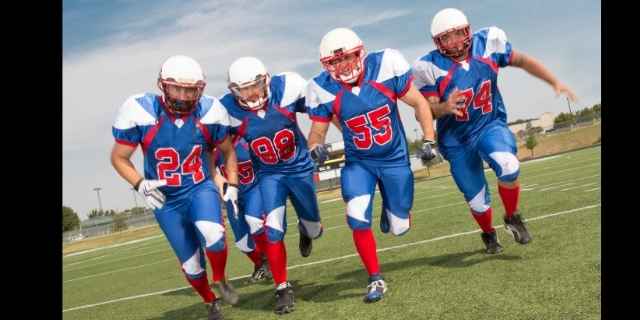“Blitz” is one of the most commonly used terms for defensive plays in American football.
This article looks at the history and evolution of blitz play. If you don’t know anything about the strategy or the sport, don’t worry. We’ll start from the beginning.
Why Is It Called A Blitz?
The word blitz comes from the World War II German term blitzkrieg, which means lightning war.
In warfare, blitzkrieg is a fast, overwhelming attack by combined groups of aircraft, tanks, and infantry. The goal is to overwhelm the opposition with a sudden and massed attack from many directions.
In football, it’s designed to be a fast, overwhelming attack on the quarterback. It includes the players who normally rush the passer, plus some others who aren’t normally involved in the rush.
Why The Basic Rush Sometimes Isn’t Enough
On every pass play, the quarterback is protected by a minimum of five players, namely the two tackles, the two guards, and the center.
The goal of the defense is to run towards the passer and disrupt his actions.
The base group of rushers is either three or four defensive linemen, depending on the formation being used.

If the defense rushes more players, they have fewer players to cover receivers downfield. They are providing the attack with more opportunity while increasing the aggression of their defense.
The blitz is a calculated risk by the defense.
Since there are fewer defenders in coverage, the players who are in coverage can’t afford to make a mistake since they will have less backup.
What Is A Blitz In Football?
A blitz is when both linebackers and defensive backs join the rush at the quarterback.
This is most commonly done by linebackers, but may also be done by cornerbacks or safeties.
The best outcome for the defending team is that they stop the pass play before it ever gets started by tackling the quarterback.
The next best outcome is that they disrupt the play by hurrying the quarterback into a poor choice or a poor throw.
All directions

If a linebacker or back starts the play by lining up on the line with the defensive lineman, it is not considered a blitz.
To be a blitz, it must be coming from the defensive backfield.
There is usually an attempt made to disguise who is blitzing, or even if there will be a blitz.
Red Dog – The Earliest Blitz
The first blitz is generally credited to Donald “Red Dog” Ettinger, a linebacker for the University of Kansas and then the New York Giants.
His first blitz most likely happened somewhere between 1948 and 50.
In those days, there were five down linemen. The defensive play involved rushing one linebacker from the backfield, giving the defense a 6 to 5 advantage on the line.
This quickly became known as a red dog.
Today, what was called a red dog is just called a linebacker blitz. Interestingly, on many teams, the blitzing linebacker or linebackers are still referred to as the dogs for that play.
1957 – Everybody Sits Up And Takes Notice
Blitzing really came into its own in 1957 during an NFL match between the New York Giants and the San Francisco 49ers.
The 49ers blitz completely overwhelmed Giants quarterback Charley Conerly and caused him to fumble five times.
This was somewhat ironic since the player credited with inventing the blitz had been a Giant himself!
1960 – The Wildcat Blitz
In 1960, St. Louis Cardinals player Larry “Wildcat” Wilson and coach Chuck Drulis came up with the first secondary blitz when safety Wilson rushed the quarterback.
The secondary consists of the deep defense, namely the cornerbacks and safeties.
This play became known as the “wildcat blitz” and is probably the first time the word blitz was used.
Because this play, and other secondary blitzes that followed it, involved the defense’s primary pass defenders, it is considered much riskier than linebacker blitzes.
Secondary blitzes are still far less common. But they have the potential to be very disruptive because the offensive doesn’t usually expect secondary players to rush.
Today, a rush can come from anyone in the secondary, not just a safety.
1980s – The Zone Blitz

The next advance in blitzing was the zone blitz.
This is sometimes credited to Bill Arnsparger, but the move was made popular by Coach Dick Lebeau’s Pittsburgh Steelers defenses in the 1980s.
In a zone blitz, one or more of the defensive linemen drop back into pass coverage. Meanwhile, the linebackers run forward to take their place in the rush.
This can be very confusing to both the quarterback and the offensive line. They have no idea who will be attacking or defending.
The zero blitz is the riskiest blitz of all. On a zero blitz, every single player attacks the line of scrimmage, leaving no one back to cover passes.
This is generally only done when the defense is fairly sure that a running play is coming.
Blitz Tactics
Blitzes are not run on every play and some teams rarely run them at all.
If your defensive line is good enough to get pressure on the quarterback by themselves, there is no real reason to give up a coverage player by blitzing him.
Also, some quarterbacks are very good at reading blitzes and throwing the ball to the gap left by the defender who is charging.
Don’t blitz Brady
For instance, it was considered very dangerous to blitz Tom Brady. This all-time great won six Super bowls with the Patriots, and one with the Buccaneers.
Part of Brady’s success is due to being so good at picking apart blitzes.
Faking it
To avoid allowing the quarterback to know what is coming, it is common to see players fake charging the line before the play and then not blitzing at all.
Meanwhile another player who was standing back charges in.
Several linebackers may fake charges just to rattle the quarterback in the hope he will make a mistake.
Switching it
Sometimes, a linebacker will only blitz depending on what the offense does. For instance, a blitz may be called where the blitzing linebacker is told to “key” on the fullback.
When the ball is snapped, if the linebacker sees that the fullback is staying in to protect, he will blitz.
If the fullback goes downfield as a receiver, that same linebacker drops into pass coverage.
Blitz Defenses
What can the attacking team do to protect the quarterback and defend against the blitz?
Changing the blocking assignments
One of the best options is to hold in some offensive backs or receivers to help block. This nullifies the numbers advantage that the blitz gives the defense.
When you see a quarterback come to the line and start yelling and pointing, that quarterback has decided a blitz is coming. He is changing the blocking assignments to deal with it.
If you watch the center, he is often doing that as well. The center is the signal-caller for the offensive line and has the power to change blocking assignments as he sees fit, right at the line.
West Coast offense
Another good tactic is short, quick release passes into the area just vacated by the defender. This is the basis of the West Coast Offense, which is based around short passes.
Often, one or more receivers have the leeway to change their route to run into an area vacated by a blitzer.
Screen passes
Screen passes are also effective against the blitz.
In a screen pass, the offensive linemen pretend to be beaten by the defenders. The defenders rush to the quarterback who quickly lobs the ball over their heads to a back or receiver who has snuck in behind the rushing defenders.
The linemen form a wall in front of ball carrier and charge down the field at any defenders who were not lured into the rush.
Power running and the rest
Blitzing tends to get players out of position for run defense.
So, sometimes the best way to deal with the blitz is to power run right at it!
It’s a constant chess match between the offenses and defenses, with blitzes, fake blitzes, and disguised blitzes all being part of it.
One tactic that can no longer be employed is the old-fashioned V formation. If you want to know more, read our article on the flying wedge in football, and why it’s now prohibited.